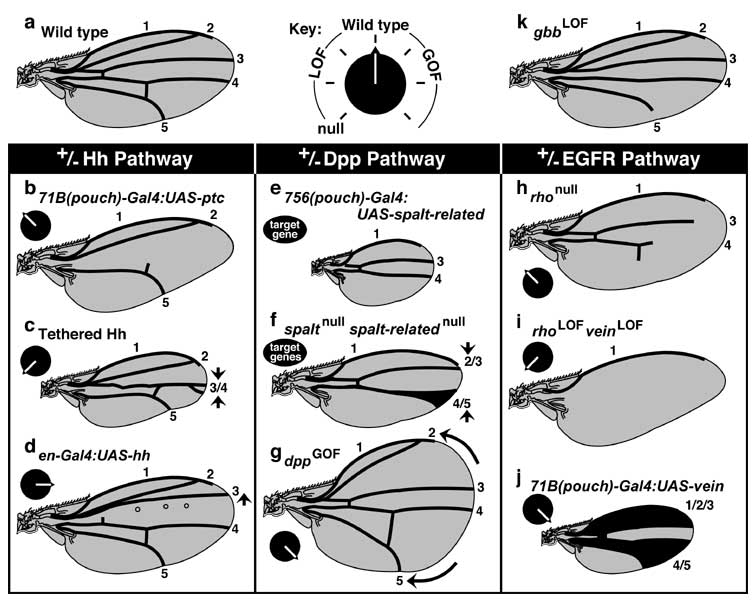Select image to enlarge

Figure 6.13
Dependence of vein pattern on signaling pathways. Black lines or areas mark veins or vein-like regions in all panels, and outer arrows denote vein displacements. For gene abbreviations see below or legend of Fig. 6.11. The key to terms (above) shows a rheostat dial with LOF and GOF settings on either side of the wild-type level of gene expression. In the panels below, this knob is turned to indicate signal amplitudes for Hh, Dpp, and Vein (or other Egfr ligands). N.B.: When a gene is driven by Gal4-UAS transactivation in an unusual region (stated in parentheses), its transcription is typically higher than in its endogenous region (hence a GOF effect) [435, 3857].
a. Wild-type wing.
b-d. Hh pathway [4478]. This pathway governs veins 3 and 4. b. Overexpressing patched (ptc) in the pouch (via various Gal4 drivers) suppresses L3 and L4 [2992]Δ (but see [4604]). Presumably, the suppression occurs because excess Ptc impedes Hh diffusion [755] and inhibits Hh transduction [2992]Δ , though not severely enough to curtail Dpp- and hence Hh-dependent growth. c. A stronger (~null) effect is obtained when the normal Hh is replaced with a tethered (non-diffusible) construct. This substitution eliminates the 3-4 intervein and collapses L3 onto L4 [4136]. Similar 3-4 fusions are seen with fusedLOF [4479]Δ , ptcGOF [2993]Δ , dispatchedLOF[572], knotLOF [2894]Δ , and oroshiganiLOF [1171] (cf. tout-veluLOF [277]), as well as in transduction-defective fuLOF [3177] or smonull [364] clones that cross from A to P. Milder narrowing of the 3-4 span is seen with EgfrGOF [4604]. d. Overexpressing Hh in the 3-4 intervein region (via en-Gal4:UAS-hh) displaces L3 anteriorly, leaving behind its 3 sensilla campaniformia (circles) [2992]. Widening of the 3-4 intervein is also seen when cholesterol is added to the larval diet [341] -- an effect attributable to the cholesterol tail that Hh acquires during its maturation [1960, 1975].
e-g. Dpp pathway [2992]. This pathway governs veins 2 and 5. e. Overexpressing the Dpp target genes spalt or spalt-related throughout the pouch eliminates L2 and L5 (and causes a smaller wing) [981, 984, 2617]. f. Deleting the entire spalt-Complex (i.e., both spalt and spalt-related) in large clones causes fusion of L2 with L3, and L4 with L5. This diagram is a composite of two wings -- one with a large A clone and the other with a large P clone (Fig. 2b & c in [986]). Similar effects are seen with dppLOF[4830]Δ , puntLOF [1674], tkvLOF[1674], and ubiquitously expressed 'Supersog' constructs [4830]. g. Overgrowth occurs pervasively -- except in the 3-4 intervein -- when dpp is overexpressed by (1) using MD-638-Gal4 or 71B-Gal4 to drive UAS-dpp throughout the wing pouch [1537, 2992], (2) using dpp-Gal4 to drive UAS-dpp along the A/P line [2954], or (3) using hs-flp-out to induce scattered dpp-ON clones in 2nd instar [4188]. This result disproves the simple Dpp Gradient Model (cf. Fig. 6.3) [2992] wherein Dpp specifies all vein positions directly [2954, 4136].
h-j. EGFR pathway [320]. This pathway is instrumental in specifying all veins (except vein 1?), but at a lower level in the control hierarchy than Hh or Dpp (cf. Fig. 6.11). Two Egfr ligands are used redundantly: Vein and a second ligand regulated by rho. Eliminating one or the other (h) depresses the pathway, but both must be disabled to shut it off entirely (i). h. When rho function is abolished (by null clones), certain veins (L1 and crossveins) or fragments (L3 and L4) remain [1643]. Similar remnants are seen in Starnull clones [1643]. i. All veins except L1 are absent in rhoLOF veinLOF double mutants [1041, 1366, 2907] due to paucity of vein initiation [320, 3015, 3624], and wing shape is altered [1041]. This trait reflects extreme synergy since neither of these weak alleles -- rhove nor vein 1-- has much of an effect by itself [1041, 1368]. Near-total vein loss is also seen with rhoLOF argosGOF [3772], rhoLOF EgfrLOF [4191], EgfrLOF rolledLOF [1043], EgfrLOF astLOF [1042], dRafGOF [2715], sproutyGOF [681, 3558], and dppLOF tkvLOF [980]. j. When 71B-Gal4 drives vein expression in the pouch, the wing is smaller, and 1-3 and 4-5 areas are vein-like [4604]. Similar effects are seen with rhoGOF [3126], rhoGOF StarGOF [1643], spitzGOF [4604], netLOF NLOF [4188], and araGOF [1536]. The immunity of the 3-4 intervein is attributable to its shortage of Egfr [1643, 4604], which, in turn, is enforced by Knot [2894]. This immunity can be overcome at high (Gal4-driven) levels of Rho [1643]. Why the area behind L5 is immune is not known.
k. Crossveins disappear when gbb (glass bottom boat) is depressed [4830], and similar defects are seen with short gastrulationGOF [4830], tolkinLOF [1233], and tolloid-related-1LOF [3111]. They are closer together in approximatedLOF, dachsLOF, dachsousLOF, and four jointedLOF (not shown) [4852]Δ .
Except for g, which is inferred from preveins in a mature disc (Fig. 2d in [4188]), all sketches (~ same scale) were traced from photos in [2072] (b), [4136] (c), [2992] (d), [984] (e), [986] (f), [1366] (h), [4604] (i), [4604] (j), and [4830] (k).
|
|
